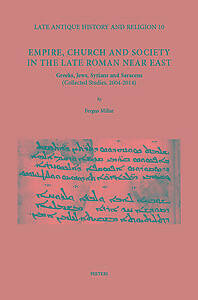
Je cadeautjes zeker op tijd in huis hebben voor de feestdagen? Kom langs in onze winkels en vind het perfecte geschenk!
- Afhalen na 1 uur in een winkel met voorraad
- Gratis thuislevering in België vanaf € 30
- Ruim aanbod met 7 miljoen producten
Je cadeautjes zeker op tijd in huis hebben voor de feestdagen? Kom langs in onze winkels en vind het perfecte geschenk!
- Afhalen na 1 uur in een winkel met voorraad
- Gratis thuislevering in België vanaf € 30
- Ruim aanbod met 7 miljoen producten
Zoeken
Empire, Church and Society in the Late Roman Near East
Greeks, Jews, Syrians and Saracens (Collected Studies, 2004-14)
F Millar
€ 212,95
+ 425 punten
Omschrijving
This book brings together thirty separate studies of the complex religious, communal and religious history of the Roman Near East in the period from the conversion of the Emperor Constantine to Christianity in CE 312 to the first Islamic invasion in CE 632. A newly-written Epilogue, 'Open Questions', reviews the different fields of study involved, and asks how far what we find helps to understand the origins of Islam. Pagan Greeks and Greek-speaking Christians, as well as Jews and Samaritans using Hebrew and Aramaic, co-existed, as did a new Christian community using Syriac, a branch of Aramaic. The complex complex and extensive evidence for this multicultural world has had to be approached in separate studies, while retaining a sense of communal co-existence and mutual relationships. The papers have been edited so as to appear in a consistent form, and are arranged in groups intended to offer a coherent overall structure. It is hoped that they will stimulate further work on this important phase in cultural and religious history.
Specificaties
Betrokkenen
- Auteur(s):
- Uitgeverij:
Inhoud
- Aantal bladzijden:
- 841
- Taal:
- Engels
- Reeks:
- Reeksnummer:
- nr. 10
Eigenschappen
- Productcode (EAN):
- 9789042932913
- Verschijningsdatum:
- 31/12/2015
- Uitvoering:
- Hardcover
- Formaat:
- Genaaid
- Afmetingen:
- 173 mm x 249 mm
- Gewicht:
- 2063 g

Alleen bij Standaard Boekhandel
+ 425 punten op je klantenkaart van Standaard Boekhandel
Beoordelingen
We publiceren alleen reviews die voldoen aan de voorwaarden voor reviews. Bekijk onze voorwaarden voor reviews.









